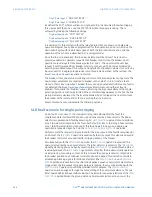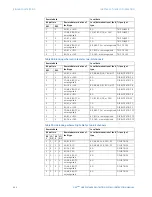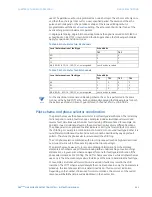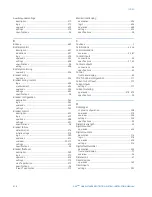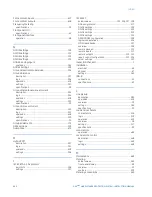
666
D90
PLUS
LINE DISTANCE PROTECTION SYSTEM – INSTRUCTION MANUAL
SINGLE-POLE TRIPPING
CHAPTER 15: THEORY OF OPERATION
This enhanced operation of the pilot-aided schemes is the reason to use a short pilot
scheme priority time when setting the trip output logic. The timer will force the scheme to
wait for a decision from the pilot scheme for a short period of time before accepting any
local trip request. The advantage, however, materializes only if two-bit or four-bit
communications channels are used, and is important only on parallel lines or when the
application requires maximum accuracy of single-pole tripping. In other cases, it is not
recommended to delay the local trip decision.
Cross-country fault example
Assume a single-pole operation application where D90
Plus
IEDs are used to protect a two-
terminal line (terminals T1 and T2) using phase and ground distance zone 1, 2 and 3
elements in a permissive overreaching transfer trip scheme. The performance of the
system with one-bit, two-bit, and four-bit communications channels is outlined for a mid-
line phase A-to-ground fault and a coincident phase B-to-ground fault just behind terminal
T2. Assume also that the reclosers are enabled and reset.
The following protection elements will pickup at terminal T1.
•
Ground distance zone 1, 2, and 3 for an AG fault.
•
Ground distance zone 2 and 3 for a BG fault.
•
Phase distance zone 2 and 3 for an AB fault.
The phase selector will determine the fault is type ABG at terminal T1. This response is
independent from the distance elements; the phase selector sees two forward faults.
The following protection elements will pickup at terminal T2.
•
Ground distance zone 1, 2, and 3 for an AG fault.
The phase selector will determine the fault is type AG at terminal T2. The reverse BG fault is
likely to be ignored.
If a one-bit channel is used, terminal T1 will trip three poles but terminal T2 will trip phase A
only (see the table below) which is undesirable.
Table 48: Trip table for cross-country fault example, one-bit channel
If a two-bit channel is used, both terminal T1 and T2 will trip phase A only (see the table
below) which is the desired outcome.
Table 49: Trip table for cross-country fault example, two-bit channel
If a four-bit channel is used, both terminal T1 and T2 will trip phase A only (see the table
below) which is the desired outcome.
Terminal
Remote data
Local data
Bit pattern
Remote
determination of fault
type
Local determination
of fault type
Trip output
RX1
T1
1
Any
MULTI-P (ABG)
TRIP 3-POLE
T2
1
Any
AG
TRIP PHASE A
Terminal
Remote data
Local data
Bit pattern
Remote
determination of fault
type
Local determination
of fault type
Trip output
RX1
RX2
T1
1
0
AG
ABG
TRIP PHASE A
T2
1
1
ABG
AG
TRIP PHASE A
Содержание D90 Plus
Страница 10: ...x D90PLUS LINE DISTANCE PROTECTION SYSTEM INSTRUCTION MANUAL TABLE OF CONTENTS ...
Страница 438: ...428 D90PLUS LINE DISTANCE PROTECTION SYSTEM INSTRUCTION MANUAL PROTECTION FLEXANALOG PARAMETERS CHAPTER 7 PROTECTION ...
Страница 502: ...492 D90PLUS LINE DISTANCE PROTECTION SYSTEM INSTRUCTION MANUAL AUTOMATION FLEXANALOG PARAMETERS CHAPTER 8 AUTOMATION ...
Страница 626: ...616 D90PLUS LINE DISTANCE PROTECTION SYSTEM INSTRUCTION MANUAL ENERVISTA SECURITY MANAGEMENT SYSTEM CHAPTER 13 SECURITY ...
Страница 678: ...668 D90PLUS LINE DISTANCE PROTECTION SYSTEM INSTRUCTION MANUAL SINGLE POLE TRIPPING CHAPTER 15 THEORY OF OPERATION ...
Страница 684: ...674 D90PLUS LINE DISTANCE PROTECTION SYSTEM INSTRUCTION MANUAL DISPOSAL CHAPTER 16 MAINTENANCE ...
Страница 686: ...676 D90PLUS LINE DISTANCE PROTECTION SYSTEM INSTRUCTION MANUAL REVISION HISTORY CHAPTER 17 APPENDIX ...



